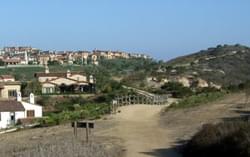




With the emphasis on health and fitness in today's society, trails are becoming just as important as streets and sidewalks in our communities.
by Randy Martin, President, Trailscape

If walking and biking are key components of an individual's fitness regimen, the trails they walk and bike on are major contributors to the "fitness" of an entire community. That's the conclusion of a recent survey published in Self magazine, which named Orange County the "Most Fit" region in the country on this year's list of the Best Places for Women. Sharing credit for that distinction, according to the magazine, are the county's 150 miles of bike trails, along with 39,000 acres of parks and 40 miles of coastline.
With the emphasis on health and fitness in today's society, trails are becoming just as important as streets and sidewalks in our communities. Offering people a place to walk, run or ride that encourages them to connect with nature is a valuable benefit that is relatively inexpensive to provide.
It is not a niche market that desires trails; it is an under-tapped mass market. A 2005 survey of potential home buyers by Brook Warrick of American Lives found that:
There are very few things in this world that almost 80% of people agree on, yet many in the development community seem to be missing this one. A well-designed trail that carefully undulates and meanders only minimally alters the land, yet it maximizes value with a minimum expenditure.
While a golf course, which is desired by 22% of the market, costs about $500,000 per hole, a natural trail costs only about $30,000 per mile.
To better understand what 79% of the market prefers, we have surveyed hikers and cyclists at local trails in Orange County, and this is what we found:
In very basic terms these are keys to thoughtfully designed trails that will last:
For construction, we suggest hiring a professional trail builder, not a grader or a landscaper. A well-built trail can last decades with minimal maintenance. A poorly built trail will be a mess by the end of the first winter and will beg for rebuilding every spring.
Put the trail in first. Often clubhouses and other amenities are held off for financial or construction reasons, but trails are inexpensive and provide immediate value. A best case scenario is to allow the trail to become a popular draw to the area well before the models, but just after entitlement. Trail users may begin to dream about how nice it would be to live next to the trail.
Market your trails. We have joined with Kovach Marketing, a leading new-home marketing firm, to offer a turnkey approach to trail design and implementation. We design the trails and Kovach designs signage along the trails and all of the marketing materials that will help developers market the trails to the end user.
Our hope is that as developers start on every new project, they will ask: "Can we make room for a trail? The bottom line is that Trails Add Value and will set a community apart!
STEP IT UP! The Surgeon General’s Call to Action to Promote Walking and Walkable Communities
posted Jan 22, 2024
The Call to Action provides strategies that communities can use to support walking, which we hope will result in long-lasting changes to improve the health and health care of Americans today and of the generations that follow.
posted Jan 2, 2024
The Winter Placemaking Guide is dedicated to community leaders, policymakers and all types of community changemakers who seek to improve their surroundings during the winter season.
posted Oct 25, 2023
A self-service guide for assessing a community’s walkability.
The Pop-Up Placemaking Tool Kit
posted Oct 18, 2023
Projects that inspire change — and improve communities for people of all ages
830 views • posted 01/19/2018